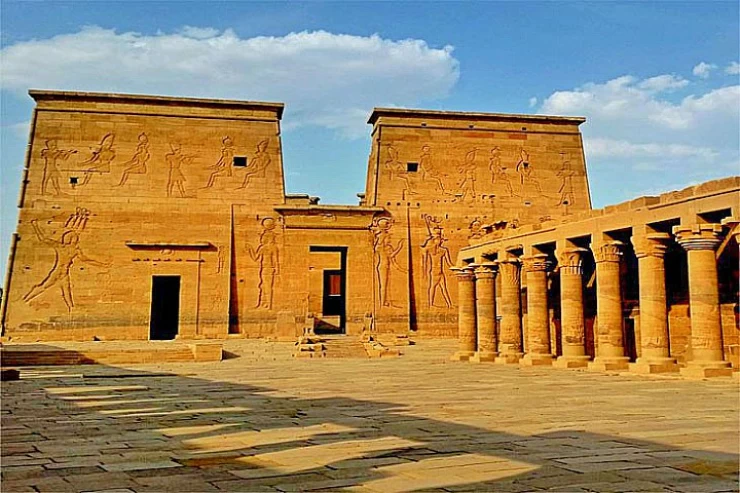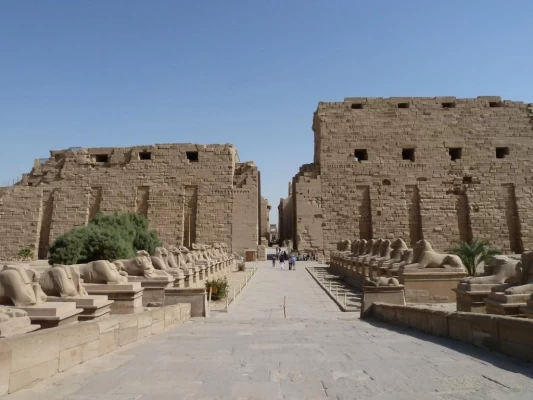
Queen Hatshepsut | Queen of Egypt | The Pharaoh Woman
The Pharaoh Woman
On the West Bank in Luxor, Queen Hatshepsut, “who took the title of Pharaoh, erected a magnificent temple to her memory at Deir el-Bahri,” according to the Ministry of Tourism and Antiquities website. Hatshepsut, whose name means “most excellent woman” in Pharaonic, is the only Egyptian queen who ruled Egypt in stable political and economic conditions during the Golden Age, the period between 1473 and 1458 BC, unlike previous queens who were characterized by turmoil during their time on the throne.
The eldest daughter of Egypt's Pharaoh Thutmose I, who had an illegitimate and very young son, Thutmose II, whom Hatshepsut accepted to marry in the tradition of Pharaonic dynasties to share rule after her father's death. After Thutmus II's death, Queen Hatshepsut declared herself a guardian of her son's throne of Thutmus II, the third. Two years later, she claimed the throne for herself.
The design of Queen Hatshepsut's temple is characterized by its ingenious style, as it looks like a temple in the arms of a mountain. It is worth noting that the designer of the temple, Sanamut, has occupied the minds of archaeologists to this day, not only for his genius in construction and architecture and his many positions, but also for his close relationship with Queen Hatshepsut, which some archaeologists attribute to a strong love affair between the powerful queen and a member of the common people.
On the walls of the temple, details of Hatshepsut's life, how she became the legitimate queen of the country, the events of the campaigns she led, along with the myth of her sacred birth and her Bible of the God Amon, were recorded. The temple consists of 3 successive floors on open terraces built entirely of limestone in the heart of the mountain, and in front of limestone columns, limestone statues of the god Osiris and Queen Hatshepsut in a magical distribution, and on the walls of the temple there are dozens of inscriptions of the naval expeditions sent by Queen Hatshepsut to Puntland to trade and bring incense from that country.
The Temple of Hatshepsut includes places for Hatshepsut's father, King Thutmose I, as well as the goddess Hathor and the goddess Anubis, and a compartment open to the sky was dedicated to the sun god “Ra Hor Achti”, and inside the temple there is the famous Holy of Holies compartment, and the walls of the temple were covered with scenes The walls of the temple are covered with scenes representing temple rituals and religious festivals, as well as the transportation of obelisks from the quarries to Karnak Temple, emphasizing the most prominent inscriptions in the central balcony of the temple, which represents Queen Hatshepsut's expedition to the country of Punt, whose population and houses were depicted, as well as the surrounding environment.
In addition to the riches and exotic animals the Egyptians brought with them from there, Hatshepsut was portrayed as the legitimate queen of the country, not only by confirming her father Thutmose I's appointment of her as his heir, but that her father was the god Amun himself.
Daughter of Pharaoh Hatshepsut, exceptionally interesting, she is one of the few women to have ruled the land in the capacity of a pharaoh. During the 18th Dynasty period (c. 1479 to 1458 BCE), this eldest daughter ruled the country as she was known for the rich and peaceful reign. Hatshepsut, instead of military campaigns, turned her attention toward trade, monumental architecture, and religious developments.
Hatshepsut is the Egyptian woman of the royalty. A daughter of Pharaoh Hatshepsut, she was among the very few women to ascend the throne in the capacity of a pharaoh. Such was during the period that is typically called the 18th Dynasty, or from around 1479-1458 BCE in Egypt. She was recognized then for having ruled during a wealthy and peaceful time in history. Rather than military campaigns, she concentrated her efforts on trade, extensive architecture, and religious developments.
The Mortuary Temple of Hatshepsut in Deir el-Bahari is her most renowned monument near Luxor. The magnificent edifice—with terraces and colonnades—stands as a testimony to the reign and the divine authority of this woman. It was under her that Egypt established trade networks, including sending an expedition to the Land of Punt, returning with gold and incense and other exotic goods.
Yet, her immediate successors, notably the stepson Thutmose III, sought to efface their names and monuments from every official record. Notwithstanding, modern archaeology has now sealed her position as one of Egypt's greatest rulers.


















